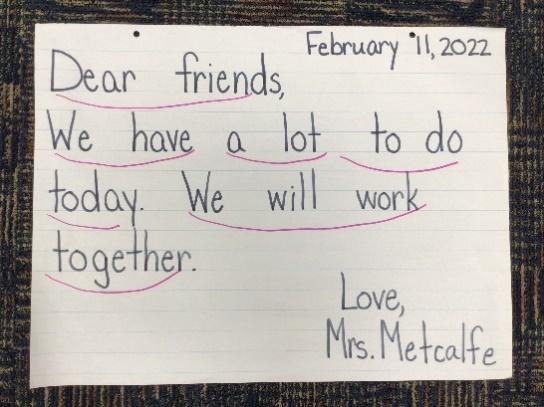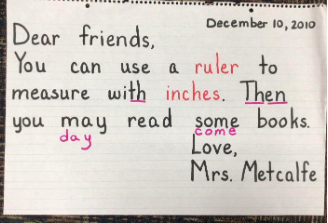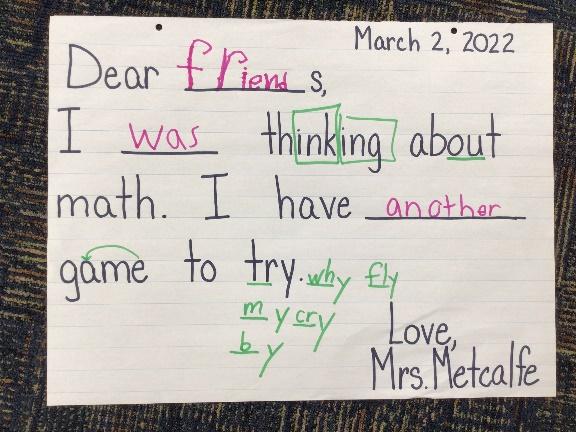The scene playing out around the morning message as students trickle in is a familiar one.
“Try it, Kento! See this? Say /g/, /l/… like that. You try it.” Naomi guides his hand under the words as bit by bit they work their way through the sentence. Behind them, Yesenia watches closely, mouthing the words as they read. When they get stuck, she quietly whispers the next part and nods as they repeat after her.
A steady stream of pairs and small groups of kids read the message chorally, helping each other solve challenging bits, or discussing the contents of the message. I stand across the room watching. I learn a lot during this time.
- Who is confident in trying to read the message before we read it together? Who hesitates?
- Which students are using things we’ve been learning? Which ones struggle to even recognize those things are in the message?
- Who not only understands what to try but can also show others how?
- What might I want to tease out when we meet as a group to read? Will I name something I saw a student doing? Do I need to front-load a bit of problem-solving?
- What are they almost doing on their own?
- Which students might be able to model for the others a bit of reading work they did as they tried the message on their own? Which students do I want to model with my guidance so they might have a more successful experience?
Morning messages provide rich opportunities to engage students in the application of all the things we are teaching them to do as readers. Being able to lift out reading moves that students are making—or ones we wish they were making—makes a reader’s thinking actions visible.
The class may read the message chorally first, and then go back to a particular spot in the text and name the things they did in that bit to read what was there. Students might provide that model, showing others the reading actions they used. Sometimes these are readers who are solid with a skill; other times they are readers who can almost do it on their own. In the highly supportive context of our work in the morning message they get a chance to feel like an expert. Other times the teacher might draw students’ attention to one part of the text, modeling how they might approach figuring out that part before they read the message as a whole. Using what we observe anytime students are reading helps us know what direction to take and what models of application our kids need.

Sometimes that application is straightforward, like in this message. Learning to read in phrases to increase fluency is not always easy, especially in longer sentences or in sentences that extend past the end of a line. Using the morning message as a place to work on this allowed us to mark up the text, showing what phrases our eyes might see quickly. Since we were reading the message chorally, it also gave readers who might struggle a chance to experience a fluent reading alongside those who were doing it more easily.

In this example we noticed and used th- to help us read some words in a message. This followed several small-group reading sessions where readers struggled to notice and use that digraph in words. Those same readers had little trouble using it during our word study block when they knew that’s what we were learning about, but when they saw those sounds in text at other times, it was a no-go.
Another reading group was working to use familiar words to help solve new words. Since most of them knew the words come and day, we were able to use those words to help us figure out some and may. While this is something kids may do as wordplay with word families, putting those experiences to work when reading authentic text may not be as natural for many young readers. Because I control the content of our morning messages, I can make word choices that provide clear, embedded opportunities to put these sorts of things to work.


In these examples students marked things like words with the cve pattern, vowel teams, and ink/ing (taught as glued sounds in our required phonics program). There is a longer word that was approached in parts and a bit of high-frequency word practice. Some of this was directed at most or all of the class; other parts were aimed at particular reading groups. Two places in the March 2 message were opportunities for individual students. One student had been struggling with the word was even though most of his classmates could already read and write that word. An English-learner had been working to say the sound /ow/.
The possibilities for differentiation when engaging with the print of a morning message are almost endless. Last week I had one student come find a word that started with /b/, the first sound of his name and a letter he is still working to learn. Another student came and showed us how she used sounds to slide through the word will. One mentioned that we should read it “more not-chopped-up” and proceeded to demonstrate how to read a sentence in phrases. The focus that day was on how they as readers might approach the text to figure out what it says.
While many morning messages focus on creating a sense of community or noticing phonics patterns or conventions of print, sometimes focusing on the actions we take as readers is what’s most important. And you’ll know when those times are—just stand back and watch. The kids will show you.



